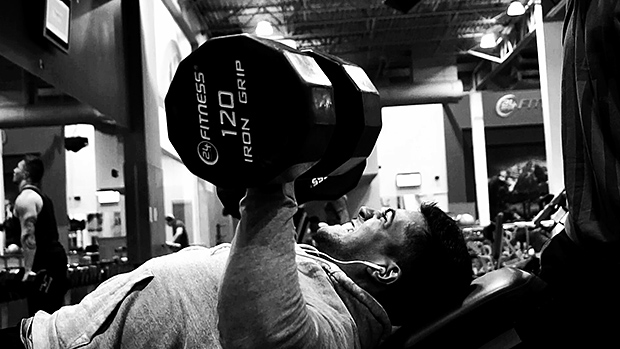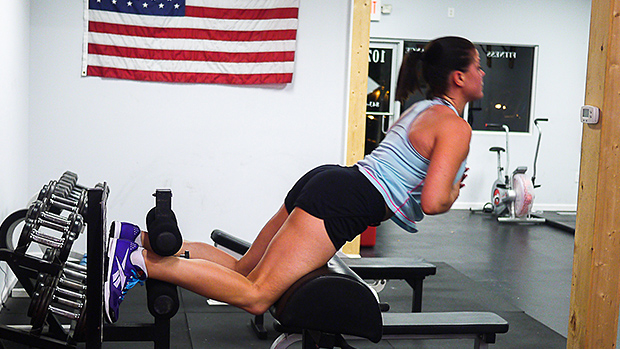I'll freely admit it. I've been extremely reluctant to sit down and write this article. Why? Well, the reasons are numerous, but it basically boils down to the pertinacity of the exercise community.
Certain values are held as sacred as 34DDs perched high atop hard-packed abs and steely glutes. (Okay, so maybe those are my sacred values.) But after discussing my cerebral interworkings with Tim "Big Man on Campus" Patterson, he convinced me that the Tasmanian devils in my head must be freed from oppression (or something along those lines). As such, I invite you to stew over the ensuing information with one caveat: you must possess an open mind.
The rate at which you'll achieve your ultimate physique is directly correlated with the amount of stimuli your muscles are exposed to. In fact, since the amount of stimuli is positively correlated with the number of training sessions, you could ascertain that frequency is the most important element that determines your rate of development. (Obviously, other variables such as sufficient parameters are important, but let's stay focused on frequency of training sessions).
This reasoning can simply be reduced to the following quantitative example. Let's say Trainee X trains each body part once every five days. Now, let's say Trainee Y trains each body part once every two days. At the end of the year, here's how they'll differ in terms of annual training sessions per body part.
Annual Macrocycle
Trainee X = 73 workouts/body part
Trainee Y = 182 workouts/body part
Even though the math – and principle – behind this example are deceptively simple, I feel such an observation is often overlooked and underappreciated. Indeed, no one worth his salt would argue that a trainee who's exposed each body part to 73 sessions/year could compete with the development of a trainee who's trained the same body part over 182 sessions.
Without too much of a leap of faith, you could even state that Trainee Y could expect more than twice the amount of development of Trainee X.
The aforementioned example leads to the obvious skepticism that 182 sessions per body part in a single year would undoubtedly lead to overtraining. Hell, maybe even a regression in development, right? For instance, look how often marathon runners are exposing their muscles to stimuli and they're some of the most scrawny and emaciated of all beings.
Not so fast, Watson! I mention this example because it frequently surfaces in the Internet swordfights between weight lifters. Obviously, weight training sessions – as opposed to long-distance running – involve significantly higher levels of intensity that target motor units in larger numbers and with a more profound ability to grow. In addition, bodybuilders understand and apply effective nutritional practices that allow for sufficient growth and recovery.
I could go on and on, but I wanted to get that out of the way. We'll return to this topic later.
Magnificently Malleable Muscles
Luckily, the skeletal muscular system is the most highly adaptable of all systems. If it weren't, we would've been extinct long ago. Or, you could simply state that those who didn't possess muscular systems adaptable enough to meet the demands of survival fell victim to Darwinism. But, if you're reading this article, I can assume that your ancestors possessed sufficient skeletal muscle malleability.
Since it's been scientifically verified that our muscles are extremely adaptable, it begs the following question: Just how adaptable are our muscles? This is a question I've been pondering for years. Through much experimentation, and a deluge of demented brain-storming, I've come to the profound realization that our muscles are significantly more adaptable than our human psyches are currently willing to accept. How did I come to this realization? By simply observing the world.
The purpose of science is to experiment with innovative protocols that help us better understand how our body works. Oftentimes these protocols are based on observations made in other relevant, or non-relevant, experiments. Moreover, experiments are often devised from observations scientists have made in the "real world."
My favorite statement relating to science is that "science is observing the world around you." As such, let's discuss those who possess the most appreciable levels of muscular development.
In order to make this observation more valid, I'm going to omit any elite, Olympic level athletes that were created from two individuals who miraculously possessed the genetic intermingling of Greek Gods. Furthermore, let's make this discussion even more relevant by focusing on two body parts that are notorious for being tightly-held under genetic predisposition: calves and forearms.
Calves, Forearms, and Frequency
When I ask you which people possess the greatest level of calf development, who comes to mind? If you've been my shadow for the last ten years, you'd know that some of the most impressive levels of calf development are owned by soccer players.
Now, let me ask you this: Would you say these athletes annually train their calves more frequently and for longer periods of time than bodybuilders? I bet you would! That's because it's absolutely true. Soccer players train their calves virtually every day and for extended periods of time (hours).
I don't know of any bodybuilder – other than Arnold – who devoted so much time to training a single body part. Ah yes, Arnold! The dude who used to hide his calves by standing in water when being photographed because his initial calf development was so pathetic; the same dude who later bombarded his calves with ferocity; the same person who said that it takes 500 hours to build an impressive set of calves; and the same fella who went on to display one of the most impressive calf improvements in history.
 |
But wait, that's not relevant since he's genetically superior, right? Well, his initial calf development – unlike his initial biceps development – sure in the hell wasn't superior!
How about forearm development? Once again, if you've been in my neck of the woods you'd have observed that most mechanics possess levels of forearm development that would make Popeye run for the hills. Do mechanics challenge their forearm musculature on a near daily basis and for hours at a time? You bet they do! If you question the validity of this statement, I recommend you run down to the nearest "Old-School Garage" to analyze the forearms of a veteran mechanic. Just don't get too close because if he gets hold of your neck, you'll also be aware of the strength that goes along with the size!
In case you didn't catch my drift, my point is this: superior muscular development takes a damn long time, therefore, more frequent training sessions are necessary for those who seek the fastest rate of development. I purposely chose soccer players and mechanics to demonstrate my point since both soccer and engine repair expose the calves and forearms to extraordinary frequency and volume.
The Frequency Dichotomy
I've been entangled in this dilemma for years since the obvious solution – training each body part every day for hours – is neither effective nor possible for most trainees. When we consider soccer players and mechanics, we need to understand that neither exposes their musculature to exhausting levels at high intensities. If they did, they wouldn't be able to maintain the necessary level of activity. We also need to understand that they built up the capacity to withstand such high "training" frequencies.
With reference to the adaptability of muscles, I really believe that we can significantly increase the rate at which our muscles recover from training. How? By exposing our muscles to more frequent training sessions, for starters.
But we have to be cautious not to overdo the stimulus and this is a tricky area. We all possess different rates of development for any given body part. In addition, our recovery rates constantly change based on the amount of rest, nutrients, and blood flow in any given period of time. Without giving away my future writings, and without giving away some of the groundbreaking advice that'll appear in my elusive book, I'm going to focus on the issue of soreness and fatigue.
Enhancement Recovery Through Necessity
If you want to improve your rate of muscular recovery, you need to learn to train through soreness while minimizing it. When I consult (ie, drink beer) with my soccer playing and wrench-turning buddies, I often ask them about their initial exposure to their professions. Specifically, I want to know how their muscles felt during the first few months.
Both parties emphatically respond, "They were sore as hell, all of the time!" In other words, I want you to learn to train through soreness. While some soreness is inevitable, we need to understand that it's a sign of strain, fatigue, and a basic lack of recovery (or so it seems). But one thing's for sure, if you don't force your muscles to develop higher rates of recovery by training through soreness, they'll never have any reason to do so. You must provide the demand in order for your muscles to adapt accordingly!
There are many modes of recovery enhancement, but I'll initially recommend two that I've found most effective: ice massage and active recovery sessions. Ice massage is an effective mode to minimize soreness and enhance recovery. I suggest you pick up the Cryocup since it makes life much easier. Or you could simply use two small, ice-filled paper cups. In either case, you'll use an entire Cryocup or paper cup on each muscle.
Charles Staley has touched on this subject in his articles but I'll give a quick recap.
– Use long, deep strokes that run the length of your muscles.
– Use an entire cup on each side of the body.
– Perform ice massage within a few hours of your training session.
The other method that works exceptionally well for recovery is an active recovery session. I discussed this in my 100 Reps to Bigger Muscles article. Basically, you'll choose an exercise that targets the muscle group you're trying to improve. You'll utilize an extremely light load (20-25% of 1RM) and perform 50 reps 2x/day, or 25 reps 4x/day (evenly spaced in either case) on your off days for that particular muscle group.
Therefore, if you start training your lagging body part every other day, you'll perform the active recovery sessions on each day in between. For example, let's say you're trying to improve your pectoral development and you performed 5x5 for bench press on Monday.
The next day you'll perform 100 reps for the DB bench press with the aforementioned parameters. This active recovery session will enhance blood flow and nutrients to the fatigued musculature and it'll expose your muscles to more frequent training sessions without overindulgence.
The Future of Waterbury's Methodology
You're probably wondering why I haven't prescribed any specific parameters based on the issue of increased frequency. There are a few reasons. First, this article was merely intended to be a glimpse of "things to come" in my writings. Second, the parameters mandate an article in itself.
But I'll tell you this: if you want to immediately incorporate this information into your training regime, I suggest you focus on one or two lagging body parts. Don't apply the following information to your entire body or else you're sure to be overtrained.
Remember, my example of soccer players and mechanics? It must be understood that they're only exposing certain muscles to the high training frequency, not their entire body.
While it's certainly possible (in my humble opinion) to build your work capacity to the point where you can train your primary muscle groups for 6-12 sessions/week, it's not an easy sell. I'm slowly building up my information stockpile so I won't bombard the muscle-seeking community with too much information, too fast.
With that said, here's a sample of what you should strive for to build up your recovery rates and muscular development.
1. Start training the lagging muscle groups every 48 hours.
2. Don't train to failure during any sets.
3. Minimize the eccentric portion (lower under control in one second or less).
4. Use different parameters for each workout throughout the week. This is imperative. The more profound the variations in sets, reps, and load, the better.
5. Use different exercises for each workout throughout the week. The more dramatic the exercise variation, the better. But merely changing your stance, hand position, or switching from barbells to dumbbells is usually sufficient.
6. Perform active recovery sessions and ice massage.
I encourage you to ponder the info in this article and apply the 6 steps to a lagging muscle group, or two. In the meantime, I'll be hammering away at my book and working on future articles that will help you accelerate your muscle-building efforts to levels our narrow-minds just aren't willing to accept. Well, currently away!




